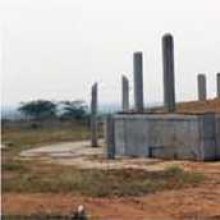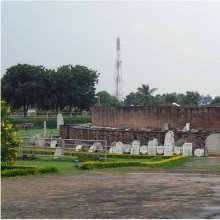Mahacaitya, Mahācaitya: 2 definitions
Introduction:
Mahacaitya means something in Hinduism, Sanskrit, the history of ancient India. If you want to know the exact meaning, history, etymology or English translation of this term then check out the descriptions on this page. Add your comment or reference to a book if you want to contribute to this summary article.
Alternative spellings of this word include Mahachaitya.
Images (photo gallery)
India history and geography
Source: Cologne Digital Sanskrit Dictionaries: Indian Epigraphical GlossaryMahācaitya.—(LL), a great caitya (q. v.). Note: mahācaitya is defined in the “Indian epigraphical glossary” as it can be found on ancient inscriptions commonly written in Sanskrit, Prakrit or Dravidian languages.

The history of India traces the identification of countries, villages, towns and other regions of India, as well as mythology, zoology, royal dynasties, rulers, tribes, local festivities and traditions and regional languages. Ancient India enjoyed religious freedom and encourages the path of Dharma, a concept common to Buddhism, Hinduism, and Jainism.
Languages of India and abroad
Sanskrit dictionary
Source: Cologne Digital Sanskrit Dictionaries: Edgerton Buddhist Hybrid Sanskrit DictionaryMahācaitya (महाचैत्य).—(nt.), ‘great holy place’, one of four, viz. the sites of Buddha's birth, enlightenment, first sermon, and parinirvāṇa: Mūla-Sarvāstivāda-Vinaya ii.113.9 f.
Sanskrit, also spelled संस्कृतम् (saṃskṛtam), is an ancient language of India commonly seen as the grandmother of the Indo-European language family (even English!). Closely allied with Prakrit and Pali, Sanskrit is more exhaustive in both grammar and terms and has the most extensive collection of literature in the world, greatly surpassing its sister-languages Greek and Latin.
See also (Relevant definitions)
Full-text: Pratyadesha, Caitya.
Relevant text
Search found 3 books and stories containing Mahacaitya, Mahācaitya; (plurals include: Mahacaityas, Mahācaityas). You can also click to the full overview containing English textual excerpts. Below are direct links for the most relevant articles:
Amaravati Art in the Context of Andhra Archaeology (by Sreyashi Ray chowdhuri)
Lower Kṛṣṇā Valley (7): Gummadidurru < [Chapter 2 - Amarāvatī and other Archaeological Sites of Ancient Andhra Pradesh]
Amarāvatī as the Centre of Buddhism < [Chapter 4 - Survival of Amarāvatī in the Context of Andhra Art]
Lower Kṛṣṇā Valley (8): Nāgārjunakoṇḍa < [Chapter 2 - Amarāvatī and other Archaeological Sites of Ancient Andhra Pradesh]
Buddhism in Andhra – Its Arrival, Spread and < [July – September, 1994]
Blue Annals (deb-ther sngon-po) (by George N. Roerich)
Chapter 28 - Paṇḍita Vanaratna < [Book 10 - The Kālacakra]

